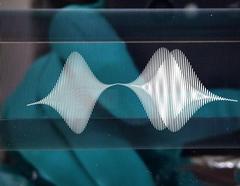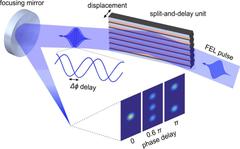URL: https://www.desy.de/news/news_search/index_eng.html
Breadcrumb Navigation
DESY News: Double flashes with attosecond precision
News
News from the DESY research centre
Double flashes with attosecond precision
Thanks to a smart mirror scientists can control the phase of X-rays from DESY's free-electron laser FLASH with attosecond precision. The feat enables new investigations of the interactions of light and matter, as the team headed by DESY scientist Tim Laarmann reports in the journal Nature Communications. An attosecond is a billionth of a billionth of a second.

The lamellar mirror splits the incoming X-ray pulse into two parts. The part reflected by the lower lamellae has a longer path of flight, resulting in a delay that can be adjusted with attosecond precision. Credit: Sergey Usenko, DESY
The scientists have now demonstrated phase control and interferometric autocorrelation at FLASH using pulse pairs created with a smart split-and-delay unit. The successful transfer of a powerful optical method towards short wavelengths paves the way towards utilization of advanced nonlinear methodologies even at partially coherent free-electron lasers that rely on self-amplified spontaneous emission (SASE). Free-electron lasers (FEL) are driven by powerful particle accelerators and produce laser-like light pulses by sending bunches of fast electrons through a magnetic slalom course.
Science with FELs has enabled multiple breakthroughs covering the broad range from basic research in life sciences to applications in material science and catalysis. Particularly, the high degree of spatial coherence of the light field allows for key applications such as serial-femtosecond X-ray crystallography, where multitudes of microcrystals are investigated with series of X-ray flashes. Recently, temporal coherence provided by seeded FELs moved into the focus of interest: “It has been shown that full control over the light phase allows for a new class of light-phase sensitive experiments in the short-wavelength limit, such as nonlinear wave mixing and attosecond coherent control,” explains principal author Sergey Usenko, who has recently graduated from the University of Hamburg with this PhD work. “These novel X-ray methodologies give a new twist to modern laser science striving to unravel energy, charge and information transport phenomena on attosecond time and nanometer length scales in matter, materials and building blocks of nature.” A nanometre is a millionth of a millimetre.
At the heart of any atomistic understanding of complex functionality such as chemical bond formation is the ultrafast motion of electrons which is dictated by the laws of quantum mechanics. “Particularly, information on the phase evolution of a wave packet, which describes electronic and/or nuclear structural changes, holds the key for its control in space and time,” as Tim Laarmann notes. “In optics, direct phase information of the propagating light wave is derived by interferometric techniques. In the last decade analogous methodologies have been developed to derive similar information on ultrafast electron wave packet dynamics in atoms, molecules, clusters and solid state materials.”
Prerequisites for these types of experiments that Laarmann’s research team pursues at the Hamburg Centre for Ultrafast Imaging are phase stability of the light source and the ability to control the temporal phase of the light wave on the corresponding sub-cycle attosecond time scale. The scientists demonstrate attosecond phase control of FEL light waves by generating two phase-locked replicas of SASE pulses and observing their interference. This opens the door for time-domain interferometry enhancing the information content of nonlinear optics experiments in the soft X-ray range even at partially coherent SASE FEL sources.

Scheme of the experimental set-up: An incoming X-ray pulse is doubled by a split-and-delay unit (SDU) and the resulting delayed double pulse is focused on a sample. Credit: Sergey Usenko, DESY
Thus, the radiation field comprising approximately 10 billion FEL photons per pulse passing the exit slit possesses a high degree of spatial and temporal coherence. A reflective split-and-delay unit (SDU) plays the key role in the experiment. The SDU splits the wavefront of the incoming FEL pulse uniformly across the beam profile by two interleaved lamellar gratings and provides two pulse replicas with a variable delay. In contrast to a conventional half-mirror SDU, the lamellar geometry provides collinear propagation of both pulse replicas and thus constant phase difference across the beam profile. This enables to record phase-resolved autocorrelation signals with maximum contrast.
“Soft X-ray interferometry requires high surface quality and position control of the reflective optics on the sub-wavelength length scale, meaning nanometre precision,” explains collaboration partner Detlef Kip from the Faculty of Electrical Engineering of the Helmut Schmidt University in Hamburg. His research group manufactured the special lamellar gratings. “Slope errors result in wavefront distortion of the corresponding partial beam and reduce the mutual spatial coherence of the pulses to the order of several percent.”
However, even this value is sufficient to observe rich interference contrast when focused on a xenon gas target. The generated spatial ion distribution depends on the relative phase (attosecond delay) between the light fields, i.e. their path-length difference induced in the SDU. This way the question how precisely one can control the phase is transformed into how precisely one can measure the delay for each FEL pulse pair. In the present experiment the exact autocorrelation delay was derived by simultaneously imaging the surface topography of the split-and-delay unit with nanometre precision using an in-vacuum white-light interferometer.
The study opens up the door for high-contrast time-domain interferometry in nonlinear phase-sensitive spectroscopic studies even at partially coherent SASE sources. Full control over the relative temporal phase in FEL pulse replicas provides opportunities to trace energy and charge migration in systems of increasing complexity with unprecedented spatial and temporal resolution. It makes the local electronic structure and dynamics accessible and controllable.
Reference:
Attosecond interferometry with self-amplified spontaneous emission of a free-electron laser; Sergey Usenko et al.; „Nature Communications“, 2017; DOI: 10.1038/NCOMMS15626



